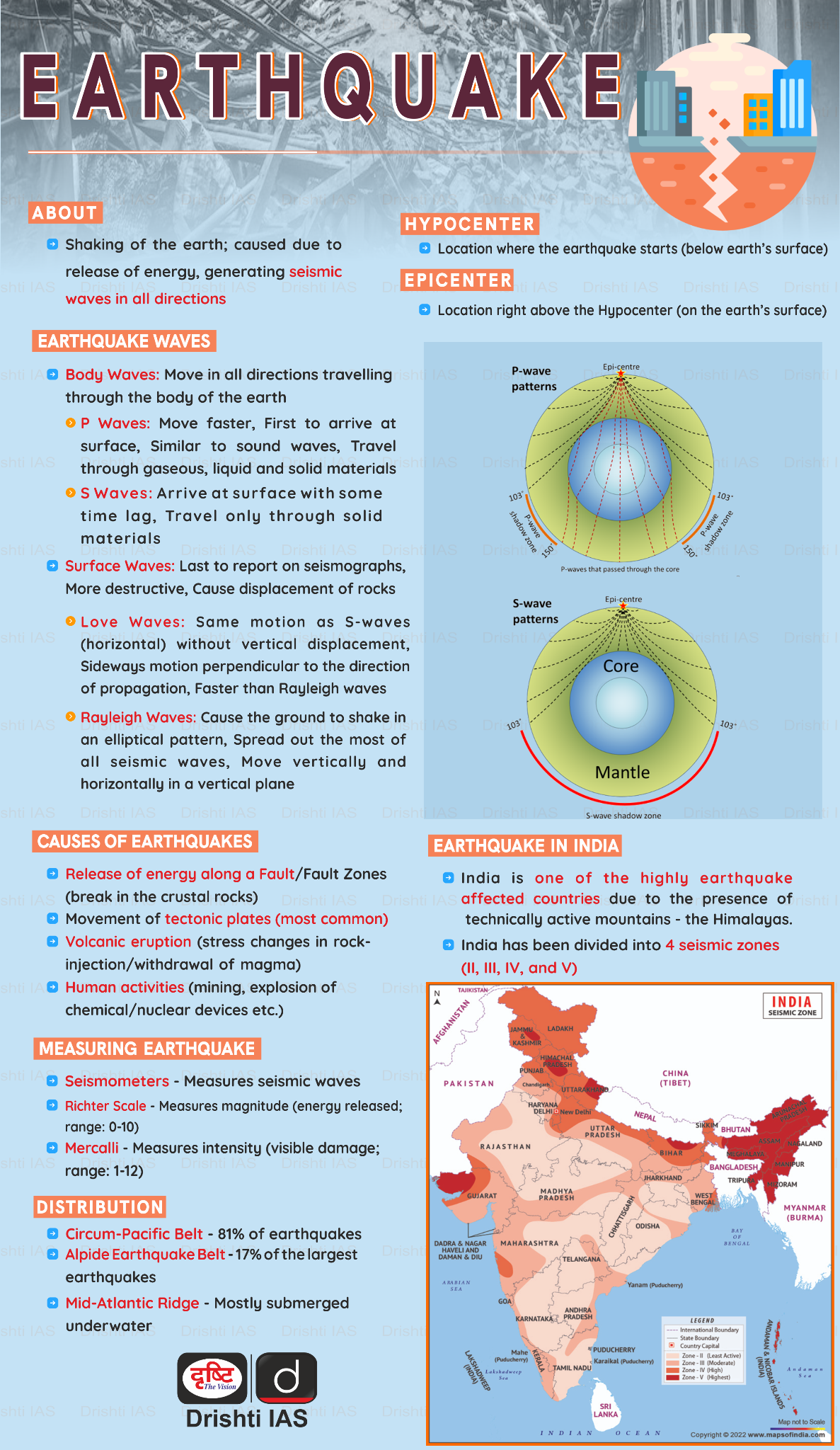Bihar Switch to Hindi
Poll Timing in Bihar Over Heatwave
Why in News?
The Election Commission of India has decided to prolong the voting period by two hours in certain areas of four parliamentary constituencies in Bihar.
Key Points
- To increase voters' participation the state's chief electoral officer has decided to extend the polling hours due to the ongoing heatwave.
- The decision follows a comparatively lower voter turnout during the initial round of polling on 19th April.
Heatwaves
- These are prolonged periods of excessively hot weather that can cause adverse impacts on human health, the environment, and the economy.
- India, being a tropical country, is particularly vulnerable to heatwaves, which have become more frequent and intense in recent years.
- India Meteorological Department (IMD) Criteria for Declaring Heat Wave in India:
- Heat waves need not be considered till the maximum temperature of a station reaches at least 40°C for Plains and at least 30°C for Hilly regions.
- If the normal maximum temperature of a station is less than or equal to 40°C, then an increase of 5°C to 6°C from the normal temperature is considered to be heat wave condition.
- Further, an increase of 7°C or more from the normal temperature is considered a severe heat wave condition.
- If the normal maximum temperature of a station is more than 40°C, then an increase of 4°C to 5°C from the normal temperature is considered to be heat wave condition. Further, an increase of 6°C or more is considered a severe heat wave condition.
- Additionally, if the actual maximum temperature remains 45°C or more irrespective of normal maximum temperature, a heat wave is declared.
Chhattisgarh Switch to Hindi
Earthquake In Chhattisgarh
Why in News?
Recently, a light magnitude of 2.6 earthquake hit 1.3 km away from Jagdalpur, Bastar district of Chhattisgarh. It had a very shallow depth of 5 km and was felt widely in the area.
Key Points
- National Center for Seismology (under the Ministry of Earth Sciences) is the nodal agency of the Government of India for monitoring of earthquake activity in the country.
- Currently, India has only 115 earthquake observatories.
- The most important aspect of the Earthquake Observatory is to be able to accurately predict the time of the earthquake.
Chhattisgarh Switch to Hindi
Rights of Persons with Disabilities Act, 2016
Why in News?
Recently, the Supreme Court expressed displeasure over the failure of some states in framing the requisite rules in implementation of the Rights of Persons with Disabilities Act, 2016.
Key Points
- According to the Act, the rule-making powers of the state include the formation of a committee for research on disability, the composition of district-level committees and prescribing salaries, allowances and other conditions of services of the state commissioner and creating funds for persons with disabilities.
- The apex court observed that it had passed several orders calling for proper implementation of the Act but several states and Union Territories were yet to fulfill their obligations.
- States and UTs like Andhra Pradesh, Chhattisgarh, Jharkhand, Punjab and Uttar Pradesh have not appointed the state commissioners.
- While Gujarat, Himachal Pradesh, Kerala, Mizoram, West Bengal, Delhi, Daman and Diu, Jammu and Kashmir, and Ladakh have not yet constituted the prescribed funds.
Rights of Persons with Disabilities Act, 2016
- The Act was passed by the Parliament of India to give effect to the United Nations Convention on the Rights of Persons with Disabilities (UNCRPD), which India ratified in 2007.
- The Act replaces the earlier Persons with Disabilities (Equal Opportunities, Protection of Rights and Full Participation) Act, 1995, which was considered inadequate and outdated in addressing the needs and challenges of persons with disabilities in India.
- One of the major changes introduced by the Act is the expansion of the definition and classification of disabilities.
- The Act recognises 21 types of disabilities, as compared to 7 types under the previous law. These are:
- Blindness, Low-vision, Leprosy cured persons,
- Hearing impairment (deaf and hard of hearing), Locomotor disability, Dwarfism,
- Intellectual disability, Mental illness, Autism spectrum disorder,
- Cerebral palsy, Muscular dystrophy, Chronic neurological conditions,
- Specific learning disabilities, Multiple sclerosis, Speech and language disability,
- Thalassemia, Hemophilia, Sickle cell disease,
- Multiple disabilities including deafblindness, Acid attack victim, and Parkinson's disease.
- It empowers the central government to notify any other category of specified disability.
- It defines a person with a disability as a person with a long-term physical, mental, intellectual or sensory impairment which, in interaction with barriers, hinders his full and effective participation in society equally with others.
- It defines a person with benchmark disability as a person with not less than 40% of a specified disability where a specified disability has not been defined in measurable terms and includes a person with a disability where a specified disability has been defined in measurable terms, as certified by the certifying authority.
- It recognises persons with disabilities have high support needs and need intensive support from others for their daily activities.
Haryana Switch to Hindi
400-Year-Old Idols Found in Haryana
Why in News?
Recently, three metal idols, estimated to be about 400 years old, were unearthed during excavation for a house construction project in Baghanki village near Manesar.
Key Points
- The police have seized the ancient idols and instructed the owner to halt construction activities.
- The Archeology Department will conduct additional excavation to search for any additional idols on the site.
- The idols recovered include a standing idol of Lord Vishnu, an idol of Goddess Lakshmi and a joint idol of Goddess Laxmi and Lord Vishnu.
Important Archaeological Sites of Haryana
- Bhirrana: A small village in Fatehabad District, is located about 220 km northwest of New Delhi. The site is situated along the ancient Saraswati riverine systems, now represented by the seasonal Ghaggar flows in modern Haryana. Hakra Ware dating back to the 8th-7th millennium BCE has been found at Bhirrana, making it contemporaneous with the early Harappan Ravi phase culture. The estimated antiquity of Bhirrana is based on charcoal samples, giving dates of 7570-7180 BCE and 6689-6201 BCE.
- Banawali: It is an archaeological site of the Indus Valley Civilization in Fatehabad district, Haryana. It is located 120 km northeast of Kalibangan and 16 km from Fatehabad, on the left bank of the dried up Sarasvati River. The excavation also uncovered a defense wall with a height of 4.5 m and thickness of 6 m, as well as well-planned houses with rooms, toilets, and streets. A flight of steps near the fortification is considered an important formation by the Archaeological Survey of India.
- Rakhigarhi: It is the largest Harappan site in the Indian subcontinent which is located in Hisar District of Haryana. The site is situated in the plains of Saraswati river, about 27 km from the seasonal Ghaggar river. To study its evolution from 6000 BC (Pre-Harappan phase) to 2500 BC, excavations were carried out at Rakhigarhi under the leadership of Archaeological Survey of India (ASI) archaeologist Amarendra Nath.








%20MPPCS%202025%20Desktop%20E.jpg)
%20MPPCS%202025%20Mobile%20E%20(1).jpg)










.png)
.png)











 PCS Parikshan
PCS Parikshan



